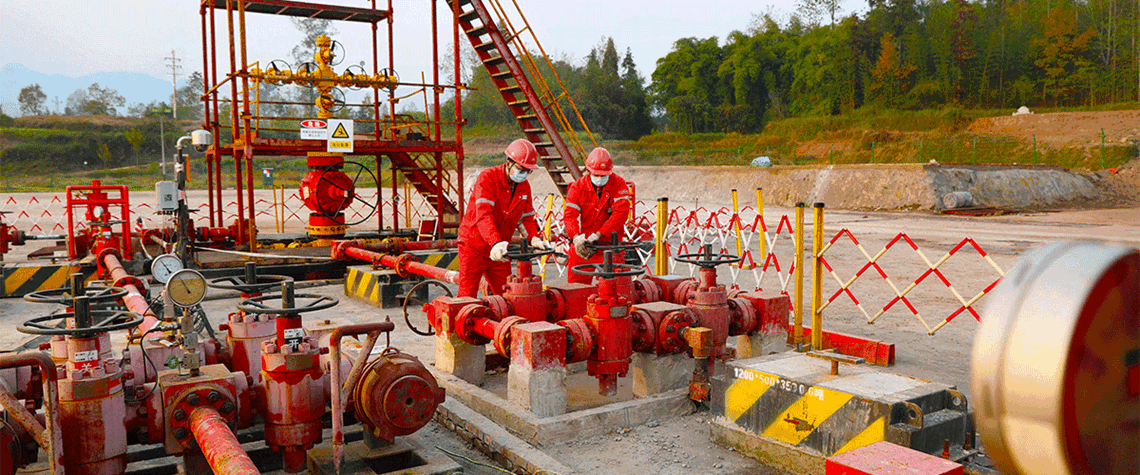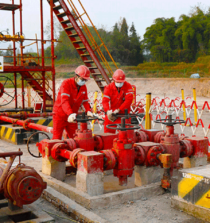Beijing’s strong emphasis on domestic production growth will require heavier investment from the country’s NOCs, as remaining reserves become harder to exploit
China’s domestic gas output will continue to grow for the rest of this decade, as the country’s energy giants eke out greater production at prolific legacy fields. But later gains could become harder to come by, as upstream development will eventually have to shift to complex frontier plays, both onshore and offshore, that are more challenging to exploit.
China has managed to increase gas output by more than 10bcm/yr for the past six years, a streak the central government is keen to continue. PetroChina, Sinopec and CNOOC—which together accounted for 83% of gas produced in China in the first nine months of this year—have persistently sustained or increased domestic investment, under government pressure to ramp up indigenous production as quickly as possible to reduce oil and gas import dependence.
From 2017—the year before President Xi Jinping first urged the NOCs to boost domestic output—to 2020, production grew by an average of 8.2%/yr, but then slowed to 7.8% in 2021 and again to 6.0% last year.
“Newly discovered reserves in recent years are not very high quality because they’re either in very deep fields or are very hard to explore” Chinese gas analyst
China produced 19bcm of gas in October, an increase of 2.6% year-on-year that was the lowest since June 2022, according to official statistics. Output over the first ten months reached 189.6bcm, an increase of 6.1% from a year ago that was marginally up from the 6.0% growth seen in the same period of 2022, but considerably slower than the 9.4% increase in 2021.
PetroChina, China’s biggest gas producer by far, expects domestic gas production to expand by 5.4% this year, to 234.6bcm, while CNOOC anticipates growth of 4.6%, to 227.8bcm, a figure that is in line with forecasts from brokers Bernstein Research.
Huge reserves, but highly complex
The NOCs are large-scale home-turf explorers, with total E&A spend across the three companies averaging more than $9b/yr over the last decade. Announced in-place volumes tend to be huge, but low recovery factors tell a different story. The NOCs are struggling against rising costs to convert deeper, more challenging resources into reserves.

The three most important factors for determining Chinese production growth potential are the size of the country’s reserves, future gas demand levels and production costs, a domestic gas analyst in Beijing told Petroleum Economist.
“If you do not have much reserves left, then you do not have much potential,” the analyst said. China had 6.57tcm of technically recoverable gas reserves at the end of 2022, along with 560.4bcm of shale gas reserves and 365.7bcm of coal bed methane (CBM), according to year-on-year changes released by the Ministry of Natural Resources in mid-June. The estimated gas reserves would be enough to last China for just under 30 years based on last year’s production rate of 220.1bcm—down marginally from nearly 31 years in 2021.
The 6.57tcm is the highest in Asia-Pacific, when excluding Russia’s prodigious resources, outstripping the likes of global LNG exporters Australia and Indonesia, but the impressive figure belies the difficulty of recovering the reserves economically.
“Newly discovered reserves in recent years are not very high quality because they are either in very deep fields or are very hard to explore. So, yes, while we are among the top countries in terms of gas reserves volume, they are very hard to exploit. If most of this gas is too costly to produce, then it will not be contributing to domestic output,” the analyst said.
“Newly discovered reserves are getting deeper and deeper. CNOOC is also drilling very deep wells offshore and they are expecting these types of wells to be their growth pillar of gas output in the future. That is what happening offshore, so I expect similar developments are occurring onshore as well.”
Production growth potential
China’s three NOCs are spending billions to rise to the challenge of unlocking increasingly complex deposits. In a world of increased capital discipline, the companies are bucking the trend and have persistently sustained or increased domestic investment to reduce oil and gas import dependence. PetroChina has been the biggest spender of the past decade, investing nearly RMB2t ($281b) in capex on E&P since 2013.
The three NOCs accounted for 83% of China’s gas output in the first nine months of 2023, according to third-quarter earnings released by the companies in late October. CNOOC’s listed arm recorded the biggest annual production gain, of c.12%, followed by Sinopec on 8.7% and PetroChina on 6.6%.
China’s upstream sector has been backed by a series of official edicts pushing for growth in gas production and exploration. Examples include the National Energy Administration’s 2019–25 seven-year action plan, which was designed to encourage major E&P players to bolster domestic upstream investments and increase hydrocarbons output between 2019 and 2025, as well as the subsidy policy for the exploitation and utilisation of tight gas, shale gas and CBM during 2020–24.
“Volatile and elevated international gas prices seen in 2022 have made China reinforce the importance of growing domestic gas production to ensure energy security and to avoid an over-reliance on imported gas,” a second gas analyst in Beijing told Petroleum Economist.
10bcm/yr— China’s domestic output growth over the past six years
“Market consensus is that 50% is the bottom line to keep for the share of domestic gas production in China’s total gas supply. With supportive policies, we expect to see China’s domestic gas production continuing to grow at a steady rate to reach 275–290bcm/yr by 2030, largely driven by unconventional gas”, the analyst said.
China is likely to continue boosting its gas output by more than 10bcm/yr for the remainder of the current five-year plan, but the growth rate could decelerate following its conclusion at the end of 2025, according to the first analyst. “My sense is output will reach around 280bcm/yr around 2030, but that will not be the peak, which will be around 2035. Maybe it can exceed 300bcm after 2030”, he stated.
China’s apparent gas consumption grew by 7% year-on-year, to 288.75bcm in the first nine months of 2023. As domestic output stood at 170.4bcm over the same period, this indicates China met 59% of January–September demand through indigenous production—down slightly from 60.4% for all of last year, when consumption and imports slumped by 1.2% and 9.9% respectively.
“Although China’s gas production is expected to increase rapidly, with the more rapid growth of China’s gas demand, we forecast the portion of domestic gas supply will gradually decrease year by year, and down to around 45% in 2030,” said the first analyst.
Policy push
The state dominance of China’s upstream sector means policy and regulation play a considerably more significant role than market forces in determining industry growth, compared with other countries.
An important indicator for China’s gas production outlook is the five-year plan, which is published by the central government every five years and outlines the roadmap for many sectors, including energy.
In the 14th Five-Year Plan (FYP), published in March 2021 and covering the 2021–25 period, Beijing called for relatively fast growth in gas production, with a target for output to reach 230bcm by 2025. Given production increased from 207.6bcm in 2021 to 220.1bcm last year, the 14th FYP target looks almost certain to be bettered. But output growth in the 15th FYP and beyond looks less certain.
Source: Petroleum Economist








